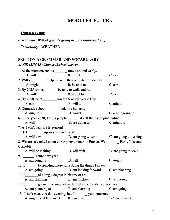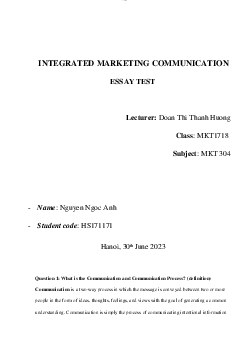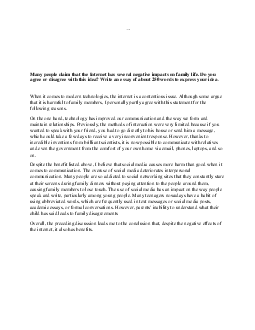



Preview text:
lOMoARcPSD| 39099223
Säo Bernardo, Brazil.Wal-Mart Stores Inc. is finding out that what plays in Peoria isn't necessarily a hit in suburban Säo Paulo.
Tanks of live trout are out; sushi is in. American footballs have been replaced by soccer balls. The
fixings forfeijoada, a medley of beef and pork in black bean stew, are now displayed on the deli counter.
American-style jeans priced at $19.99 have been dropped in favor of $9.99 knock-offs.
But adapting to local tastes may have been the easy part. Three years after embarking on a blitz to
bring "everyday low prices" to the emerging markets of Brazil and Argentina, Wal-Mart is finding the going tougher than expected.
Brutal competition, markets that don't play to WalMart's ability to achieve efficiency through economies of
scale, and some of its own mistakes have produced red ink. Moreover, the company's insistence on doing things
"the Wal-Mart way" has apparently alienated some local suppliers and employees. DEEP POCKETS
No one is counting Wal-Mart out, of course. With sales of nearly $105 billion last year and profits of
$3.1 billion, the Bentonville, Arkansas, behemoth has deep lets pockets. And it has revised
merchandising in Brazil and Argentina and made other chanes. Its four newest stores are smaller than
the initial outlets in in Säo Paulo and Buenos Aires and are in midsize cities where competition isn't so fierce.
Bob L. Martin, Wal-Mart's head of international operations, is confident that the company will eventually
become the dominant retailer in South America. "There is low-hanging fruit all over the place," he says. "The
market is ripe and wide open for us." He adds that Wal-Mart plans to add eight stores in both Argentina and Brazil
next year, doubling the number now in each counü•y.
A lot is riding on Wal-Mart's global expansion drive, which is targeting not only South America but also China
and Indonesia, two other markets full of promise and pitfalls. With opportunities for growth dwindling at home,
the company is opening fewer than 100 domestic stores a year, down from as many as 150 in the early 1990s. The
current rate of openings can't generate the profit gains that Wal-Mart wants, and its main hopes lie overseas.
"If we're good enough in international, we can duplicate Wal-Mart," chief executive David D. Glass said in an
interview in June. "We have very high expectations." A SMALL OPERATION SO FAR
So far, though, the six-year-old international operation is relatively tiny; it accounted for only 4.8 percent of Wal-
Mart's 1996 sales. Most of the company's international revenue comes from Canada, where WalMart purchased
120 stores from Woolworth Corp. in 1994, and from Mexico, where earlier this year it bought a controlling stake
in Cifra, SA, its partner, and now has about 390 stores. Last year, the international unit had an operating profit of
$24 million, its first, compared with a $16 million loss in 1995. Mr. Martin says he expects further improvement
this year. Mr. Glass said he expects international growth to account for a third of WalMart's annual increase in
sales and profits within three to five years.
The performance of Wal-Mart's 16 South American stores may well indicate the future outlook. In Canada and Mexico,
many customers were familiar with the company from cross-border shopping trips, and by acquiring local retailers, WalMart
quickly reached the size necessary to hold down costs. In South America and Asia, by contrast, Wal-Mart is building from
scratch in markets already dominated by savvy local and foreign competitors such as Grupo Päo de Acucar SA of Brazil and Carrefour SA of France. LOSSES FORECAST
Wal-Mart doesn't break out financial data on its South American Operations. However, retail analysts, citing the accounts of
Wal-Mart's Brazilian partner, Lojas Americanas SA, expectWa1-Mart to lose $20 million to $30 million in Brazil this year,
on top of an estimated $48 million in losses since starting up in South America in 1995. In Argentina, where the company
doesn't have a partner, Wal-Mart executives concede that it is losing money but say its performance meets expectations. The
company expects operations in both countries to be profitable by early 1999.
'What counts is that we are finding great customer acceptance," Mr. Martin says. Wal-Mart says its supercenter
in Osasco, Brazil, was the top-grossing store in the entire company last year. And at a recent supercenter opening lOMoARcPSD| 39099223
in the mid-size Brazilian city of Ribeiräo Préto, shoppers practically beat down the doors to scoop up bargain-
priced microwave ovens and television sets.
But such enthusiasm is hard to sustain. At an older supercenter in Avellaneda, a suburb of Buenos Aires, a few
shoppers are in the store during peak hours one Sunday. Hugo and Mariana Faojo help explain why. Browsing in
the shoe section, the young couple say they see little difference between the goods at WalMart and those at nearby
Carrefour. For groceries, they prefer Supermercados Jumbo SA, a Chileanowned chain, where they say they find
high-quality products and fresh meats. Clothes and household goods, Wal-Mart's mainstays, are similar in quality
and price to those at Carrefour, says Mr. Faojo, a government surveyor.
Not only did Carrefour arrive first—it now has a total of about 60 stores in Argentina and Brazil—
but it is maneuvering with prices and promotions to keep Wal-Mart off balance. When Thomas
Gallegos, who manages Wal-Mart's new store here, prints up fliers advertising bargains, the nearby
Carrefour responds in just a few hours by offering the same product for a few cents less—and its fliers
are handed out at the entrance to the Wal-Mart parking lot. "Geez, the competition is aggressive," says
Mr. Gallegos, who previously ran a Wal-Mart in Harlingen, Texas.
Carrefour, which, like Wal-Mart in the United States, drives hard bargains with its suppliers, can
afford to play low-ball because it has the critical mass that Wal-Mart lacks here. And it holds down its
overhead by stocking a far-narrower selection of merchandise; for example, the Carrefour in La Plata,
Argentina, stocks 22,000 items, while the Wal-Mart next door carries 58,000.
Mr. Martin contends that Carrefour's advantage is ephemeral and that customers value Wal-Mart's
broader choice. "It's costing them something to fight us," he adds. Carrefour didn't respond to requests for an interview. DISTRIBUTION PROBLEMS
Right now, however, Wal-Mart's effort to stock such a wide variety of merchandise is hurting it. Squeezing out
costs in the supply chain is crucial to its "everyday low pricing" formula. In the United States, the company runs
like a well-oiled machine, maintaining a highly sophisticated inventory-management system and its own network of distribution centers.
But timely delivery of merchandise is a relative concept in the bumper-to-bumper traffic of Säo Paulo,
where Wal-Mart depends on suppliers or contract truckers to deliver most of its goods directly to stores.
Because it doesn't own its distribution system, it can't control deliveries nearly as well as 'it does in the
United States, vendors say. Stores here sometimes process 300 deliveries daily, compared with seven a
day at U.S. locations, and some shipments have mysteriously disappeared somewhere between the port and the store.
"The biggest issue Wal-Mart has is shipping product on time and getting it on the shelf," says Jim Russel,
a national account manager for ColgatePalmolive Co. in Bentonville. Wal-Mart recently built a warehouse
in Argentina and one in Brazil that it says will eventually reduce its distribution problems.
But logistics aren't the only issue. Some local suppliers have difficulty meeting Wal-Mart's specifications
for easy-to-handle packaging and quality control, forcing the retailer to rely so heavily on imported goods
that it could have problems if Brazil's economic stabilization policies falter. Eleven South American
suppliers have taken umbrage at Wal-Mart's aggressive pricing policies and for a time refused to sell goods to the chain.
Wal-Mart also has sought to drive hard bargains with divisions of its major suppliers back in the United States. The pitch
hasn't been altogether successful. Wal-Mart doesn't get special deals just because it's a big U.S. customer, some large domestic suppliers say. VARIOUS MISTAKES
Wal-Mart's troubles in South America stem partly from its own mistakes. Analysts say it failed to do its homework
before plunging in. In addition to the live trout and American footballs, the company initially imported items such
as cordless tools, which few South Americans use, and leaf blowers, which are useless in a concrete jungle such as Säo Paulo. lOMoARcPSD| 39099223
And merchandise flubs weren't the only mistakes. In Brazil, Wal-Mart brought in stock-handling equipment that didn't
work with standardized local pallets. It also installed a computerized bookkeeping system that failed to take into account
Brazil's wildly complicated tax system. Vincente Trius, who heads Wal-Mart's Brazilian operations, says, however, that the
company hasn't lost money as a result of tax miscalculations.
Wal-Mart has also been slow to adapt to Brazil's fast-changing credit culture. Not until last February did the
company start accepting postdated checks, which have become the most common form of credit since Brazil
stabilized its currency in 1995. Päo de Acucar, whose Extra hypermarkets compete with Wal-Mart, has been taking postdated checks since
they first became popular and has installed a sophisticated credit-checking system at its registers. WalMart is hurrying to do so, too.
The six South American Sam's Club locations, the members-only warehouse stores that sell merchandise
in bulk, got off to a slow start largely because shoppers weren't used to paying a membership fee and don't
have enough room at home to store bulk purchases. In Argentina the clubs have faced another barrier:
Smallbusiness customers are reluctant to sign up for fear Wal-Mart could provide tax information to the
authorities on their purchases.
Wal-Mart won't disclose Sam's Club membership data in South America. But it now offers shoppers free one-day
memberships tied to specific purchases.
Mr. Martin says that Wal-Mart is "disappointed" in the club's performance in Argentina but that it is improving in Brazil. The
company says it plans more Sam's outlets in South America but hasn't disclosed details. PROBLEMS CALLED TEMPORARY
Wal-Mart's Mr. Glass characterized the missteps as temporary problems and inevitable in entering a new market.
"It's a lengthy process to go to South America, recruit good managers, bring them to WalMart, and
train them and indoctrinate them and teach them what you want to teach them," he said in June. "It's slow
going early on, and you spend a lot of money. You pay a lot of tuition to learn what you need to learn."
Wal-Mart says that it is developing a strong group of young executives and hasn't suffered high turnover. But
Francisco de Narvaez, the owner of Argentine supermarket chain Casa Tia SA, says some managers have left because
Wal-Mart "didn't listen to their senior-level local employees." In the past six months, Wal-Mart has hired two managers who
had worked at its Mexican operations to take over two Säo Paulo locations.
Mr. Trius, a Spanish-born executive who earlier turned around Dairy Farm Ltd.'s Spanish supermarket chain, says he
believes the criticisms of Wal-Mart's South Arnerican operations go too far. "If Joe Blow was to open in Brazil with the
same concept and within two years had everything in place, people would say, 'What an incredible job,"' he says. "People
expected us to snap our fingers and be Wal-Mart in the United States overnight. To me, the criticisms are more related to
expectations than to reality." Identified Problems:
1. Cultural Adaptation: Wal-Mart is struggling to adapt to local tastes and preferences in Brazil and
Argentina, which goes beyond changing product offerings to understanding the local market dynamics.
2. Intense Competition: The retail markets in Brazil and Argentina are highly competitive, with strong
local and international competitors like Grupo Päo de Acucar SA and Carrefour SA. Wal-Mart faces
challenges in establishing a foothold in markets dominated by savvy competitors.
3. Supply Chain and Logistics: The lack of a well-established distribution system in Brazil, where Wal-
Mart relies on suppliers and contract truckers, leads to challenges in timely delivery and stock
management. The local traffic conditions in São Paulo add to the complexity of logistics.
4. Product Assortment: Wal-Mart's attempt to offer a wide variety of merchandise may not align with
the preferences of South American consumers, and the company faces challenges in maintaining its
"everyday low pricing" formula.
5. Mistakes in Market Entry: Wal-Mart made various mistakes, including importing products that were
not suitable for the local market, using stock-handling equipment incompatible with local standards,
and installing a bookkeeping system that didn't account for Brazil's complex tax system. lOMoARcPSD| 39099223
6. Credit Culture: Wal-Mart was slow to adapt to Brazil's evolving credit culture, such as accepting
postdated checks, which are common forms of credit in the region.
7. Sam's Club Performance: The Sam's Club concept faced challenges in South America, including
slow adoption due to resistance to membership fees and concerns about privacy, as well as the logistics
of storing bulk purchases in smaller homes.
8. Employee and Supplier Relations: Wal-Mart's insistence on doing things "the Wal-Mart way" has
reportedly alienated some local suppliers and employees. High turnover of managers and criticism of
not listening to senior-level local employees are reported issues. Impacts:
1. Financial Losses: Wal-Mart is facing financial losses in Brazil and Argentina, with estimated losses of
$20-30 million in Brazil in a single year.
2. Market Share: The company is struggling to gain a significant market share in the face of aggressive
competition, potentially impacting its long-term growth prospects in South America.
3. Brand Perception: The brand perception may be affected as Wal-Mart is perceived as not adapting
effectively to local markets and making mistakes in its market entry strategy.
Solutions and Experimental Examples:
1. Cultural Sensitivity Training: Implement cultural sensitivity training for employees to better understand
and adapt to local tastes, preferences, and market dynamics.
2. Supply Chain Optimization: Invest in optimizing the supply chain and distribution system, possibly
through establishing its own distribution centers to gain better control over the delivery process.
3. Market Research: Conduct extensive market research before entering a new market, ensuring that
products and services align with local preferences and needs.
4. Localized Merchandising: Tailor the product assortment to better match local consumer demands,
avoiding the importation of items that may not be relevant to the local market.
5. Strategic Partnerships: Establish strategic partnerships with local suppliers and businesses to build better
relations and gain insights into the local market.
6. Adaptive Pricing Strategies: Implement adaptive pricing strategies that consider the local economic
conditions and purchasing power to attract a wider customer base.
7. Employee Engagement: Improve employee engagement by incorporating feedback from local
employees, fostering a more inclusive decision-making process.
8. Customer Loyalty Programs: Introduce customer loyalty programs or incentives to encourage repeat
business, especially in markets where competition is intense.
9. Flexible Store Formats: Experiment with flexible store formats based on the local market size and
competition, moving away from a one-size-fits-all approach.
10. Continuous Improvement: Implement a continuous improvement process, learning from mistakes and
adapting strategies based on the evolving market conditions. Implications:
1. Long-Term Success: Successfully addressing these challenges can contribute to Wal-Mart's longterm
success in South America and other emerging markets.
2. Brand Image: Effective solutions will help enhance the brand image and reputation, showcasing
adaptability and commitment to local markets.
3. Market Expansion: Overcoming current issues will pave the way for further market expansion and the
achievement of Wal-Mart's goals in South America.
4. Global Growth: Successfully navigating challenges in South America will strengthen Wal-Mart's
position for global growth, especially in other promising markets like China and Indonesia.
It's important for Wal-Mart to remain flexible, learn from its experiences, and adapt its strategies to the specific
challenges presented by each local market.




